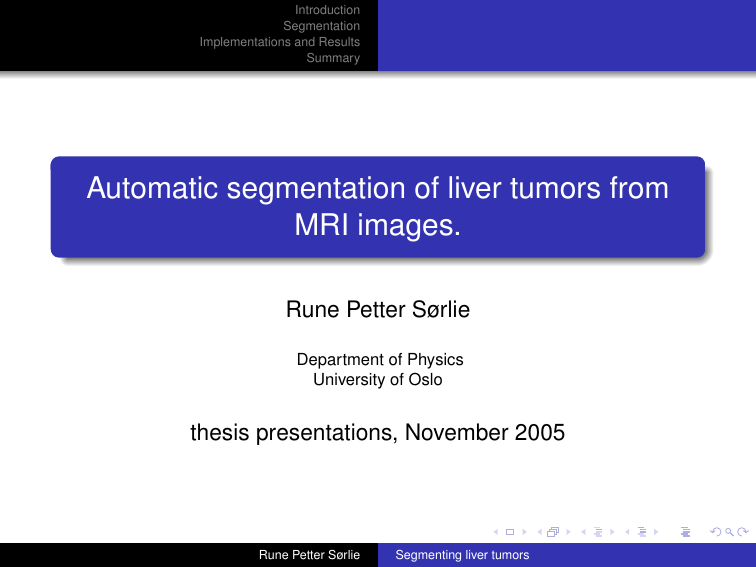Automatic segmentation of liver tumors from MRI images. Rune Petter Sørlie
advertisement

Introduction
Segmentation
Implementations and Results
Summary
Automatic segmentation of liver tumors from
MRI images.
Rune Petter Sørlie
Department of Physics
University of Oslo
thesis presentations, November 2005
Rune Petter Sørlie
Segmenting liver tumors
Introduction
Segmentation
Implementations and Results
Summary
Outline
1
Introduction
Treating liver tumors
Guidance of probes
Monitoring the process
2
Segmentation
Preprocessing
Thresholding and edge detection
Methods
Evaluation of segmentation
3
Implementations and Results
Segmentation Results
Discussion
Rune Petter Sørlie
Segmenting liver tumors
Introduction
Segmentation
Implementations and Results
Summary
Treating liver tumors
Guidance of probes
Monitoring the process
Introduction
Want an automatic segmentation of liver tumors.
Support Laparascopic procedures.
Utilize the Open MR-scanner at IVS.
Improve patient treatment.
The thesis present three segmentation methods
Snakes
Level set methods
Watershed segmentation
Rune Petter Sørlie
Segmenting liver tumors
Introduction
Segmentation
Implementations and Results
Summary
Treating liver tumors
Guidance of probes
Monitoring the process
Magnetic Resonance imaging (MRI)
A historical perspective
1946 - Nuclear magnetic resonance discovered.
1972 - First image found place.
1986 - Norway bought their first MR-scanners.
MRI advantages
Excellent contrast detail of soft tissue.
Image caption in any plane.
Easy image interpretation.
Rune Petter Sørlie
Segmenting liver tumors
Introduction
Segmentation
Implementations and Results
Summary
Treating liver tumors
Guidance of probes
Monitoring the process
Methods to destroy a tumor.
We will show two probe based methods which allow minimum
invasive treatment.
Cryoablation
RF ablation
Pros and cons
Less risk of infections.
Patients will restore to health sooner.
Not suitable for tumors >3cm.
High rate of metastases reoccurances (Cryo).
Fails to damage cells near major vessels.
Rune Petter Sørlie
Segmenting liver tumors
Introduction
Segmentation
Implementations and Results
Summary
Treating liver tumors
Guidance of probes
Monitoring the process
Cryoablation
Cryoablation uses liquid nitrogen to freeze the tisse surounding
the probe. At about -40◦ C the cell membrane cracks and the
cells are damaged.
Rune Petter Sørlie
Segmenting liver tumors
Introduction
Segmentation
Implementations and Results
Summary
Treating liver tumors
Guidance of probes
Monitoring the process
Cryoablation
Typical tumor is 2-3cm and a rim of 1cm around the tumor is
frozen.
Rune Petter Sørlie
Segmenting liver tumors
Introduction
Segmentation
Implementations and Results
Summary
Treating liver tumors
Guidance of probes
Monitoring the process
RF ablation
Makes use of Radio Frequency alternating current to heat up
tissue. Cures tumors <3cm.
Rune Petter Sørlie
Segmenting liver tumors
Introduction
Segmentation
Implementations and Results
Summary
Treating liver tumors
Guidance of probes
Monitoring the process
Guidance and probes
Both methods make use of probes. The surgeon want guidance
when inserting the probe into the tumor. Different modalities
are used
A combination of CT and ultrasound
Fluoroscopy (X-ray)
IVS use the Open MR scanner.
Rune Petter Sørlie
Segmenting liver tumors
Introduction
Segmentation
Implementations and Results
Summary
Treating liver tumors
Guidance of probes
Monitoring the process
Monitoring ablation
We will search to optimize the ratio of damaged cells and tumor
cells.
Must eliminate all tumor cells
Minimize ablation of healthy cells
Possible by thermal monitoring
Makes use of a thermal model
Rune Petter Sørlie
Segmenting liver tumors
Introduction
Segmentation
Implementations and Results
Summary
Treating liver tumors
Guidance of probes
Monitoring the process
Principal of RF ablation
Rune Petter Sørlie
Segmenting liver tumors
Introduction
Segmentation
Implementations and Results
Summary
Treating liver tumors
Guidance of probes
Monitoring the process
Diagnostic image/pre surgery
Rune Petter Sørlie
Segmenting liver tumors
Introduction
Segmentation
Implementations and Results
Summary
Treating liver tumors
Guidance of probes
Monitoring the process
Guidance of the RF-probe
Rune Petter Sørlie
Segmenting liver tumors
Introduction
Segmentation
Implementations and Results
Summary
Treating liver tumors
Guidance of probes
Monitoring the process
24 hours after treatment
Rune Petter Sørlie
Segmenting liver tumors
Introduction
Segmentation
Implementations and Results
Summary
Treating liver tumors
Guidance of probes
Monitoring the process
9 months later, complete treatment
Rune Petter Sørlie
Segmenting liver tumors
Introduction
Segmentation
Implementations and Results
Summary
Preprocessing
Thresholding and edge detection
Methods
Evaluation of segmentation
The need for preprocessing
Adjust for variable background light
Estimate background by smoothing
Subtract estimated background from input image
Dealing with Artifacts
Echoes from vessels
Patient movements –> blurred image
Best handled by a new image
Rune Petter Sørlie
Segmenting liver tumors
Introduction
Segmentation
Implementations and Results
Summary
Preprocessing
Thresholding and edge detection
Methods
Evaluation of segmentation
cont. The need for preprocessing
Tissue variations looks like noise. The smoothing dilemma
Remove speckle
Conserve edges
Smoothing approaches
Degree of smoothing
Size and orientation of filter kernel
Median/Mean/Gauss filtering
Iterated smoothing
Rune Petter Sørlie
Segmenting liver tumors
Introduction
Segmentation
Implementations and Results
Summary
Preprocessing
Thresholding and edge detection
Methods
Evaluation of segmentation
Thresholding
Gray level thresholding
Basic approach
Objects presented as regions
Neighborhood information ignored
Local threshold, Canny filter
Adaptive to local gray level
Finds to many edges or...
Does not make a closed curve
Rune Petter Sørlie
Segmenting liver tumors
Introduction
Segmentation
Implementations and Results
Summary
Preprocessing
Thresholding and edge detection
Methods
Evaluation of segmentation
Connected edge
Finding a connected edge by using contours
Snakes
Level set methods
Region based segmentation
Watershed segmentation
Rune Petter Sørlie
Segmenting liver tumors
Introduction
Segmentation
Implementations and Results
Summary
Preprocessing
Thresholding and edge detection
Methods
Evaluation of segmentation
Snakes, an active contour
Described as a parametric curvature v (s) = [x(s), y (s)]. The
snake will fit into the image with use of energy minimization.
∗
Esnake
Z
1
{Eint (v (s)) + Eimage (v (s)) + Econ (v (s))}ds
=
(1)
0
Z
Eint =
0
1
1
(α|v 0 (s)|2 + β|v 00 (s)|2 )
2
Eimage = −|∇I(x, y )|2
Rune Petter Sørlie
Segmenting liver tumors
(2)
(3)
Introduction
Segmentation
Implementations and Results
Summary
Preprocessing
Thresholding and edge detection
Methods
Evaluation of segmentation
GVF snakes
Snake steered with Gradient Vector Flow. To minimize energy,
must satisfy the Euler equation
αx 00 (s) − βx 0000 (s) − ∇Eext = 0
(4)
written as a force balance equation
(p)
Fint + Fext = 0
(p)
where Fint = αx 00 (s) − βx 0000 (s) and Fext = −∇Eext
Rune Petter Sørlie
Segmenting liver tumors
(5)
Introduction
Segmentation
Implementations and Results
Summary
Preprocessing
Thresholding and edge detection
Methods
Evaluation of segmentation
Let snake function x be a function of s and time, x(s, t)
Sets the partial derivative of x, xt (s, t) = ∂x/∂t to zero.
Then equation 6 gives the snake position for equilibrium.
xt (s, t) = αx 00 (s) − βx 0000 (s) − ∇Eext
(6)
Introduces a computational diffusion on homogeneous areas.
Rune Petter Sørlie
Segmenting liver tumors
Introduction
Segmentation
Implementations and Results
Summary
Preprocessing
Thresholding and edge detection
Methods
Evaluation of segmentation
GVF snake
Rune Petter Sørlie
Segmenting liver tumors
Introduction
Segmentation
Implementations and Results
Summary
Preprocessing
Thresholding and edge detection
Methods
Evaluation of segmentation
Principle of the Level set method
Based on moving curvature.
Adds one dimention to the problem domain
Parameterizing har limitations
Corners
Change in topology
Rune Petter Sørlie
Segmenting liver tumors
Introduction
Segmentation
Implementations and Results
Summary
Preprocessing
Thresholding and edge detection
Methods
Evaluation of segmentation
Level set
The propagation is described by a speed function F which can
be a function of curvature κ.
κ=
gxx gy2 − 2gxy gx gy + gyy gx2
(gx2 + gy2 )3/2
Rune Petter Sørlie
Segmenting liver tumors
(7)
Introduction
Segmentation
Implementations and Results
Summary
Preprocessing
Thresholding and edge detection
Methods
Evaluation of segmentation
Level set
The propagation is described by a speed function F which can
be a function of curvature κ.
κ=
gxx gy2 − 2gxy gx gy + gyy gx2
(gx2 + gy2 )3/2
Rune Petter Sørlie
Segmenting liver tumors
(8)
Introduction
Segmentation
Implementations and Results
Summary
Preprocessing
Thresholding and edge detection
Methods
Evaluation of segmentation
The Threshold Level Set Method
P(x) =
g(x) − L , g(x) ≤ C
U − g(x) , g(x) > C
where C =
Rune Petter Sørlie
U −L
+L
2
Segmenting liver tumors
(9)
Introduction
Segmentation
Implementations and Results
Summary
Preprocessing
Thresholding and edge detection
Methods
Evaluation of segmentation
Threshold Level set segmentation
Propagation term P
Rune Petter Sørlie
Segmenting liver tumors
Introduction
Segmentation
Implementations and Results
Summary
Preprocessing
Thresholding and edge detection
Methods
Evaluation of segmentation
Watershed segmentation
Watershed segmentation simplified to one dimension
Terrain model, slow and inaccurate
Bottom-up approach
Oversegmentation solved with postprocessing (hierarchy,
min. depth)
Rune Petter Sørlie
Segmenting liver tumors
Introduction
Segmentation
Implementations and Results
Summary
Preprocessing
Thresholding and edge detection
Methods
Evaluation of segmentation
The need for a referance
Evaluate the segmentation against the truth?
A gold standard
Manual segmentation
Synthetic images
Rune Petter Sørlie
Segmenting liver tumors
Introduction
Segmentation
Implementations and Results
Summary
Preprocessing
Thresholding and edge detection
Methods
Evaluation of segmentation
Dice Similarity Coefficient (DSC)
DSC usefull for messure of spatial overlap. For two regions A
and B, DSC is given by
DSC(A, B) =
2(A ∩ B)
A+B
no overlap, DSC=0
full overlap, DSC=1
Rune Petter Sørlie
Segmenting liver tumors
(10)
Introduction
Segmentation
Implementations and Results
Summary
Segmentation Results
Discussion
Snake
Segmentation with GVF snake
Rune Petter Sørlie
Segmenting liver tumors
Introduction
Segmentation
Implementations and Results
Summary
Segmentation Results
Discussion
Snake
same image, other initialization
Rune Petter Sørlie
Segmenting liver tumors
Introduction
Segmentation
Implementations and Results
Summary
Segmentation Results
Discussion
frametitleSnake Detail of GVF field
Rune Petter Sørlie
Segmenting liver tumors
Introduction
Segmentation
Implementations and Results
Summary
Segmentation Results
Discussion
Level set segmentation
Fastmarching level set segmentation
Initialized to (135, 135), σ = 1.0, α = −0.20, β =
4.0, threshold = 100, stopvalue = 100.
Rune Petter Sørlie
Segmenting liver tumors
Introduction
Segmentation
Implementations and Results
Summary
Segmentation Results
Discussion
Watershed segmentation
Iterations=5, conductance=3.0, lower threshold=0.01, max
depth=0.20
Rune Petter Sørlie
Segmenting liver tumors
Introduction
Segmentation
Implementations and Results
Summary
Segmentation Results
Discussion
Level set segmentation in 3D, Exam 2212
Threshold level set: seedpoint = (98, 137, 14), radius = 12,
thresholds: L = 50, U = 70.
Rune Petter Sørlie
Segmenting liver tumors
Introduction
Segmentation
Implementations and Results
Summary
Segmentation Results
Discussion
Level set segmentation in 3D
seedpoint = (140, 167, 9), radius = 5, thresholds: L = 0,
respectively U = 58 and U = 55
Rune Petter Sørlie
Segmenting liver tumors
Introduction
Segmentation
Implementations and Results
Summary
Segmentation Results
Discussion
Interpreting the results
method
snake
threshold level set
watershed
parameters
r= 4.0
r= 6.0
r=10.0
r=14.5
u=135
u=140
u=145
t=0.01, d=0.20
t=0.001, d=0.20
t=0.02, d=0.18
DSC
0.756
0.916
0.944
0.903
0.902
0.916
0.899
0.896
0.896
0.896
time (s)
1.24
1.32
1.17
1.18
1.36
2.23
1.31
10.20
11.20
9.80
r=radius, u=upper threshold, t=lower threshold and d=max.
depth.
Rune Petter Sørlie
Segmenting liver tumors
Introduction
Segmentation
Implementations and Results
Summary
Summary
Most liver tumors possible to segment automatic.
Quality of segmentation close to manual segmentation.
Until recently ITK is used to segment organ and their
subparts.
Time has come to include tumor segmentation in ITK
based applications.
Rune Petter Sørlie
Segmenting liver tumors
Introduction
Segmentation
Implementations and Results
Summary
Questions?
Rune Petter Sørlie
Segmenting liver tumors








